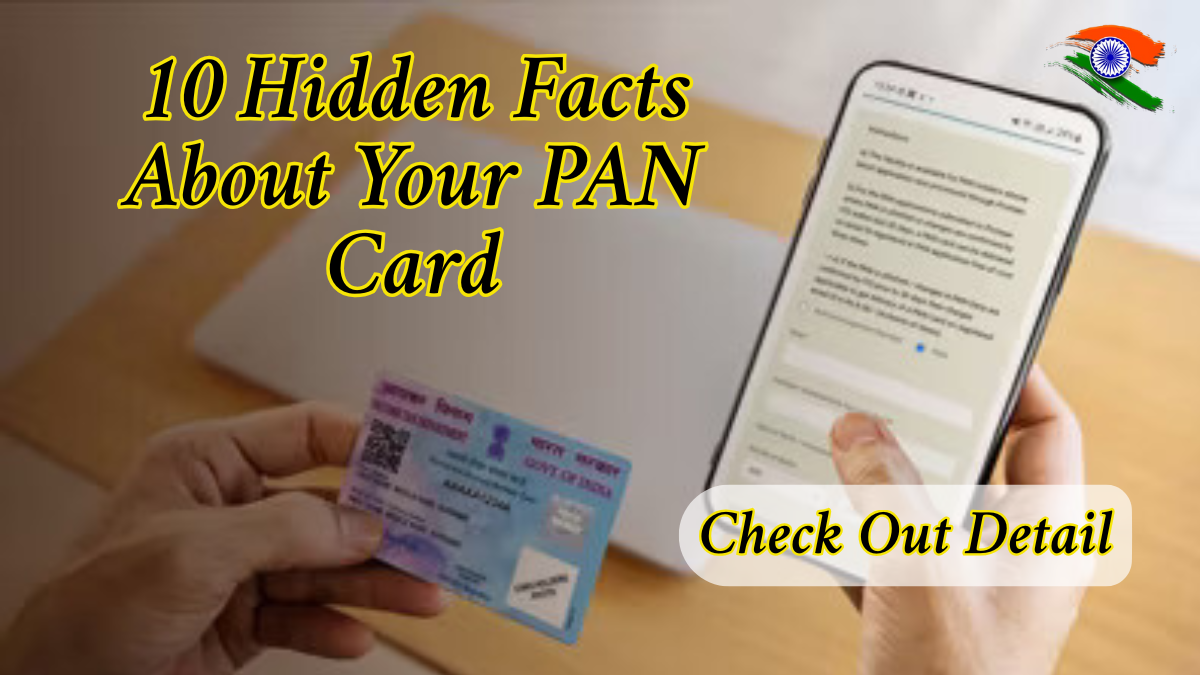The Permanent Account Number (PAN) card is among the most essential identity and financial documents for Indian citizens, alongside the Aadhaar and Ration cards. Issued by the Income Tax Department of India, the PAN card is not just required for tax filing but is also mandatory for several financial transactions, including opening bank accounts, buying property, investing in securities, and more.

What many people don’t know is that the 10-character alphanumeric PAN number contains encoded information about the holder. In this comprehensive guide, we’ll decode each part of the PAN number and share 10 key facts that everyone should know.
Table of Contents
Short Summary Table: PAN Card
Feature |
Details |
|---|---|
Document Name |
Permanent Account Number (PAN) |
Issuing Authority |
Income Tax Department, Government of India |
Structure |
10-character alphanumeric (e.g., ABCPP1234D) |
Purpose |
Unique identification for tax and financial transactions |
First 3 Characters |
Alphabetic series (AAA to ZZZ) |
4th Character |
Identifies entity type (Individual, Company, Firm, etc.) |
5th Character |
First letter of the PAN holder’s surname |
Next 4 Characters |
Numeric series from 0001 to 9999 |
10th Character |
Alphabetic check digit (random alphabet) |
Official Website |
What is a PAN Card?
The PAN card is a 10-digit unique alphanumeric identifier issued to Indian taxpayers by the Income Tax Department under the supervision of the Central Board of Direct Taxes (CBDT). It serves as a universal identification key for tracking financial transactions and preventing tax evasion.
PAN is mandatory for:
- Filing income tax returns
- Opening a bank account
- Buying or selling assets above a specified value
- Applying for loans and credit cards
- Investing in mutual funds or shares
Why is PAN Unique and Permanent?
The term Permanent Account Number indicates that each number is unique and assigned for life. Once allotted, a PAN number remains unchanged even if the individual changes address, name, or occupation. This is critical for the Income Tax Department to track financial behavior and ensure consistent tax monitoring.
PAN cannot be duplicated. Any individual attempting to get multiple PAN cards is liable for penalty and legal action under the Income Tax Act.
Structure of the PAN Number: Explained
Let’s break down the 10-character PAN number using an example: ABCPD1234F
1. First Three Characters – Alphabetic Series
The first three letters (e.g., ABC) are a sequence of three alphabets from AAA to ZZZ. These are randomly assigned and do not signify anything specific about the PAN holder.
2. Fourth Character – Type of Entity
The fourth character is crucial. It indicates the type of entity that owns the PAN. This helps classify the PAN holder in the Income Tax system.
Code |
Entity Type |
|---|---|
P |
Individual |
C |
Company |
H |
Hindu Undivided Family (HUF) |
A |
Association of Persons (AOP) |
B |
Body of Individuals (BOI) |
G |
Government |
J |
Artificial Juridical Person |
L |
Local Authority |
F |
Firm |
T |
Trust |
So, if your PAN number’s fourth character is ‘P’, it signifies that the PAN was issued to an individual.
3. Fifth Character – Surname Initial
The fifth character of the PAN is an alphabet that corresponds to the first letter of the PAN holder’s surname or last name.
For instance:
- If your surname is Desai, the fifth character in your PAN will be D.
- If your surname changes after marriage or otherwise, the PAN number will not change.
This character is directly linked to your personal details as provided at the time of application.
4. Sixth to Ninth Characters – Numeric Series
These four characters are random numbers in a running sequence from 0001 to 9999. They form part of the serial number of the PAN card issued and help ensure uniqueness.
For example, in the number ABCPD1234, “1234” is a numeric identifier issued sequentially.
5. Tenth Character – Check Digit
The last character is an alphabetical check digit, which is generated through a formula using the preceding nine characters. It ensures the validity and accuracy of the PAN number.
This check digit helps prevent any typographical or digital errors while verifying PAN numbers in official systems.
10 Hidden Facts About Your PAN Card
- Permanent and Unique: No two individuals or entities can ever share the same PAN.
- Surname Encoded: The 5th character of your PAN reveals the first letter of your surname.
- Entity Type Disclosed: The 4th character of your PAN shows whether you are an individual, firm, or other entity.
- Check Digit Safeguard: The last character ensures data integrity and prevents forgery.
- Government Regulated: Issued by the Income Tax Department under strict algorithms.
- Linked to All Financial Activity: Used across banks, stock markets, and real estate.
- Mandatory for High-Value Transactions: Required for buying/selling assets, property, jewelry, etc.
- Doesn’t Change with Address: PAN stays the same regardless of address or state.
- Linked with Aadhaar: PAN must be linked with Aadhaar to remain valid for tax purposes.
- Penalty for Multiple PANs: Holding more than one PAN is illegal and punishable.
How to Apply for a PAN Card
You can apply for a PAN card both online and offline.
Online Application
- Visit the NSDL or UTIITSL official website.
- Fill the online application form (Form 49A for Indian citizens).
- Upload required documents (ID proof, address proof, photograph).
- Pay the applicable fee.
- Track your PAN status using the acknowledgment number.
Official Websites
- NSDL PAN Services
- Income Tax Department PAN Portal
FAQs About PAN Card
1. Can a person hold more than one PAN card?
Ans. No. Holding multiple PAN cards is illegal and can attract a fine of up to ₹10,000 under Section 272B of the Income Tax Act.
2. What should I do if there is a mistake in my PAN card?
Ans. You can apply for a correction online via NSDL or UTIITSL portals and submit relevant supporting documents.
3. Is it mandatory to link PAN with Aadhaar?
Ans. Yes. The government has mandated the linking of PAN and Aadhaar for all individuals filing income tax returns.
4. What happens if my PAN card is lost?
Ans. You can apply for a reprint or duplicate PAN through the official NSDL or UTIITSL portals.
5. Is PAN required for minors?
Ans. Minors can have a PAN card if they are involved in financial transactions. Their guardians can apply on their behalf.
6. What is the validity of a PAN card?
Ans. PAN cards are valid for a lifetime and do not expire.
Conclusion
Your PAN card is more than just a tax document — it is a powerful identifier with vital information embedded in its unique 10-character code. Understanding the structure and hidden meanings behind each character of your PAN can help you stay informed and vigilant.
Whether you’re filing taxes, buying property, or opening a bank account, your PAN card plays an essential role. Keeping it secure and updated is not just a matter of compliance, but also of financial identity protection.
Official Website for PAN Services:
https://www.incometax.gov.in
For More Information Click Here




